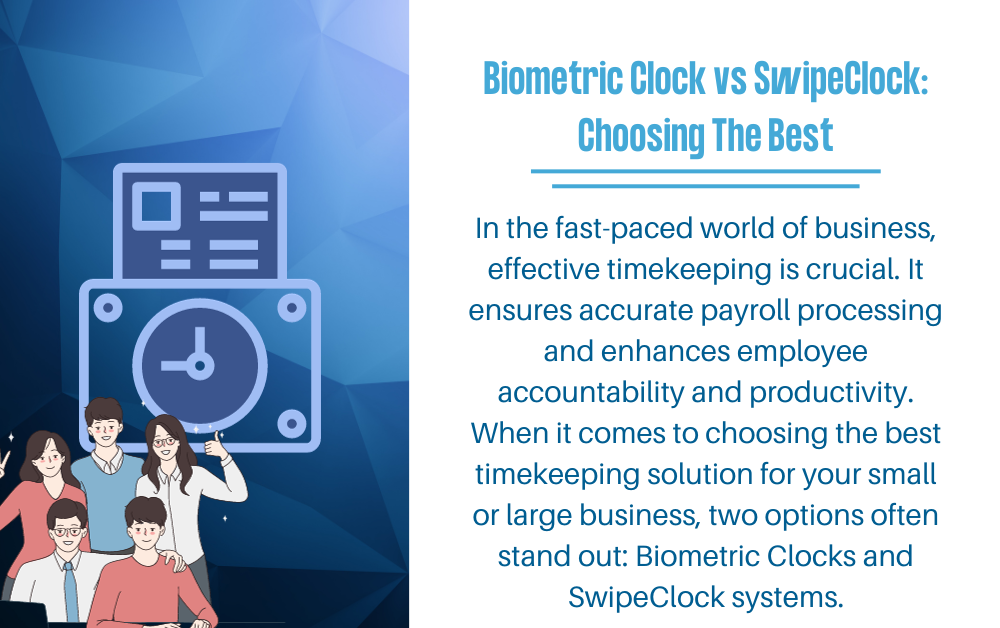In the fast-paced world of business, effective timekeeping is crucial. It not only ensures accurate payroll processing but also enhances employee accountability and productivity. When it comes to choosing the best timekeeping solution for your small or large business, two options often stand out: Biometric Clocks and SwipeClock systems. In this blog, we’ll explore the differences, benefits, and considerations of each, helping you make an informed decision that suits your company’s needs.
The Biometric Clock Advantage
1. Enhanced Security: Biometric clocks, also known as fingerprint time clocks, offer an unparalleled level of security. They rely on unique biological characteristics like fingerprints, retina scans, or facial recognition to verify employee identities. This ensures that only authorized personnel can clock in and out, reducing time fraud and buddy punching significantly.
2. Accuracy: Biometric clocks eliminate the possibility of human error associated with manual data entry. Employees can’t clock in or out for one another, which results in accurate time records for payroll and attendance tracking.
3. Streamlined Processes: These clocks are incredibly user-friendly. Employees simply need to scan their fingerprint or use another biometric method to record their time, making the process quick and efficient.
4. Cost-Efficiency: While the initial investment may seem higher than some alternatives, biometric clocks can save you money in the long run by reducing payroll errors and preventing time theft.
5. Compliance: Biometric clocks can help ensure your business complies with labor laws and regulations, as they provide a secure audit trail for tracking employee hours and attendance.
The SwipeClock Solution
1. Versatility: SwipeClock systems offer a wide range of timekeeping options, including swipe cards, proximity cards, and PIN entry. This versatility allows businesses to choose the method that best suits their needs.
2. Scalability: SwipeClock systems can easily scale with your business. Whether you have a handful of employees or thousands, you can adapt the system to your size without much hassle.
3. Accessibility: SwipeClock systems often come with user-friendly interfaces and mobile apps that allow employees to clock in and out from their smartphones or tablets. This flexibility is especially valuable for businesses with remote or off-site workers.
4. Integration: SwipeClock systems can integrate seamlessly with other HR and payroll software, streamlining your administrative processes and reducing the risk of data entry errors.
5. Cost-Effective Entry Point: If budget constraints are a concern, SwipeClock systems can be an attractive option due to their lower initial setup costs compared to some biometric alternatives.
Choosing the Right Solution for Your Business
To make the best decision for your business, consider the following factors:
1. Size of Your Business: Biometric clocks are ideal for larger enterprises with a higher risk of time fraud, while SwipeClock systems can be a versatile solution for businesses of all sizes.
2. Budget: Evaluate your budget constraints, keeping in mind the long-term savings that biometric clocks can offer through enhanced accuracy and security.
3. Security Needs: If security is paramount for your business, biometric clocks provide the highest level of protection against time theft and unauthorized access.
4. Employee Convenience: Consider the convenience factor for your employees. SwipeClock systems may be more suitable for businesses with remote or field-based workers.
5. Integration Requirements: If you already use HR or payroll software, ensure that your chosen timekeeping solution can integrate seamlessly.
In conclusion, both Biometric Clocks and SwipeClock systems offer valuable features for timekeeping in businesses of varying sizes. Your choice should align with your specific needs, budget, and security considerations. Ultimately, investing in an effective timekeeping solution ensures accurate records, boosts productivity, and helps your business thrive in today’s competitive landscape.

